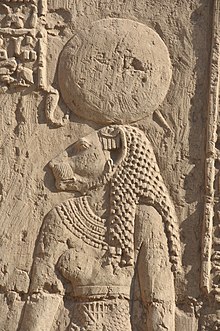Repit
| Repit in hieroglyphics | ||||||
|---|---|---|---|---|---|---|
| ideogram | ||||||
| Old empire |
|
|||||
| Middle realm |
|
|||||
| New kingdom |
Reput / Repit Rpwt / Rpyt noble woman / lady |
|||||
| Greek | Θριφις (Triphis) | |||||

Repit ( ancient Egyptian Rpwt, Rpyt ) is a lion-headed goddess of Egyptian mythology who had her main place of worship in Athribis , Upper Egypt .
Names
The name Repit means "noble woman" and was initially an honorary title for the goddesses Hathor , Isis and Nephthys . The name has been documented for Hathor since the Middle Kingdom . It was often used in the late period , especially their place of worship in Dendera was often referred to as the "House of Repit".
Isis and Nephthys were sometimes summarized as "the two noble ladies" ( rpw.tj ). Repit then became a proper name for a lion goddess from the 9th Upper Egyptian district in the Middle Kingdom , although this was mainly passed down at a later time. In vulgar parlance, the name became T-Repit with an article and then Triphis among the Greeks .
Places of worship and mythology
The main cult place of the Repit was in Athribis in Upper Egypt, in the western part of the Min-Gau, which is why it was often called "Horus Eye on the western side of Achmim". There she formed a trinity of gods with Min and Kolanthes , which are now largely destroyed in the main temple and in the temple of Ptolemy XII. was worshiped. Sometimes she also merged there with the lion goddess Sachmet . In Achmim , Repit merged with the goddess Aperetiset and was given the nickname “Aperetiset in the moon house”, which sometimes became her real name. Aperetiset ("the one with a prepared seat") was a human-shaped goddess with a Hathor crown and pair of feathers and was represented with Repit in the wake of Min. Another worship with Min and Kolanthes took place in Ptolemais Hermiu .
Mythologically, the goddess was identified with the eye of Re and (like Min) associated with the legendary punt . In the story The Homecoming of the Goddess she appears as Sopdet and Tefnut .
See also
literature
- Hans Bonnet : Real Lexicon of Egyptian Religious History. 3rd, unchanged edition, de Gruyter, Berlin / New York 2000, ISBN 3-11-016884-7 , pp. 838-839, → Triphis.
- Christian Leitz u. a .: Lexicon of the Egyptian gods and names of gods . (LGG) Vol. 6, Peeters, Leuven 2002, ISBN 90-429-1151-4 , pp. 662-666.
Remarks
- ↑ Thesaurus .
- ^ Adolf Erman , Hermann Grapow : Dictionary of the Egyptian language. Vol. 2.2: References to WB Vol. II. Akademie-Verlag, Berlin 1971, pp. 415, 2, 3, 20.
- ↑ Hermann Junker : The hour watch in the Osirismysteria, based on the inscriptions by Dendera, Edfu and Philae (= Austrian Academy of Sciences -Wien; Philosophical-Historical Class. ). Hölder, Vienna 1910, pp. 77, 118, 121.
- ^ Hans Ostenfeldt Lange, Heinrich Schäfer : Catalog général. Gravestones and memorial stones from the Middle Kingdom. Vol. I, Reichsdruckerei, Berlin 1902, p. 341 ( full text online )
- ↑ Hans Bonnet: Reallexikon der Ägyptischen Religionsgeschichte. Berlin 2000, pp. 838-839, → Triphis.
- ↑ Kolanthes, the child wore a nickname among other things, Sa-Aset Osiris ( "son of Isis and Osiris") and Iua-who-Tepi-en-Min ( "Great first heir to the minutes").
- ↑ Flinders Petrie : Athribis. Quaritch, London 1908, plates 16/7.
- ↑ a b Alexander Scharff: A memorial stone from the Roman Empire from Achmim. In: Journal for Egyptian Language and Antiquity. (ZÄS) No. 62, Leipzig 1926, p. 91
- ↑ The "moon house" was probably part of the temple of Achmim .
- ^ Henri Gauthier: La déesse Triphis. In: Bulletin de l'Institut Français d'Archéologie Orientale. (BIFAO) No. 3, 1903, pp. 165ff.
- ↑ Alexandre Moret : Le jugement des morts en Égypte et hors d'Égypte Conférences faites au Musée Guimet par G. Lafaye [u. a.] In: Annales du Musée Guimet, Bibliothèque de vulgarisation. No. 32, Paris 1909, No. 42.
